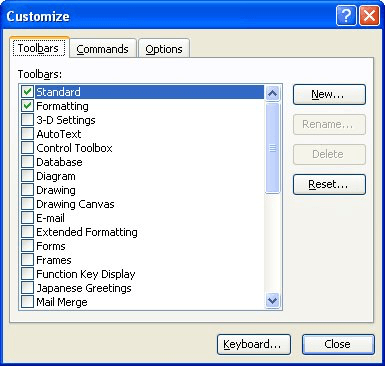Written by Allen Wyatt (last updated September 25, 2021)
This tip applies to Word 97, 2000, 2002, and 2003
Word is a very flexible program. You can configure it to work just about any way you can imagine. For instance, you can create a macro, and then add it to a toolbar. How you do this depends on which version of Word you are using.
If you are using a version of Word prior to Word 2007, then follow these steps:

Figure 1. The Toolbars tab of the Customize dialog box.
Word 2007 is different; it doesn't technically have toolbars like older versions of Word had. You can't make additions or changes to the ribbon, but you can add macros to the Quick Access toolbar. Follow these steps:
Note:
WordTips is your source for cost-effective Microsoft Word training. (Microsoft Word is the most popular word processing software in the world.) This tip (1879) applies to Microsoft Word 97, 2000, 2002, and 2003.

Discover the Power of Microsoft Office This beginner-friendly guide reveals the expert tips and strategies you need to skyrocket your productivity and use Office 365 like a pro. Mastering software like Word, Excel, and PowerPoint is essential to be more efficient and advance your career. Simple lessons guide you through every step, providing the knowledge you need to get started. Check out Microsoft Office 365 For Beginners today!
If you know how to create macros, you can easily create entire replacements for Word's internal commands. Here's all you ...
Discover MoreWhen processing a document with a macro, you may need to have the macro repaginate the text. It's easy to do using the ...
Discover MoreIf you use the INCLUDEPICTURE field to add images to your document, you may love the macro in this tip. It allows you to ...
Discover MoreFREE SERVICE: Get tips like this every week in WordTips, a free productivity newsletter. Enter your address and click "Subscribe."
There are currently no comments for this tip. (Be the first to leave your comment—just use the simple form above!)
Got a version of Word that uses the menu interface (Word 97, Word 2000, Word 2002, or Word 2003)? This site is for you! If you use a later version of Word, visit our WordTips site focusing on the ribbon interface.
Visit the WordTips channel on YouTube
FREE SERVICE: Get tips like this every week in WordTips, a free productivity newsletter. Enter your address and click "Subscribe."
Copyright © 2026 Sharon Parq Associates, Inc.
Comments